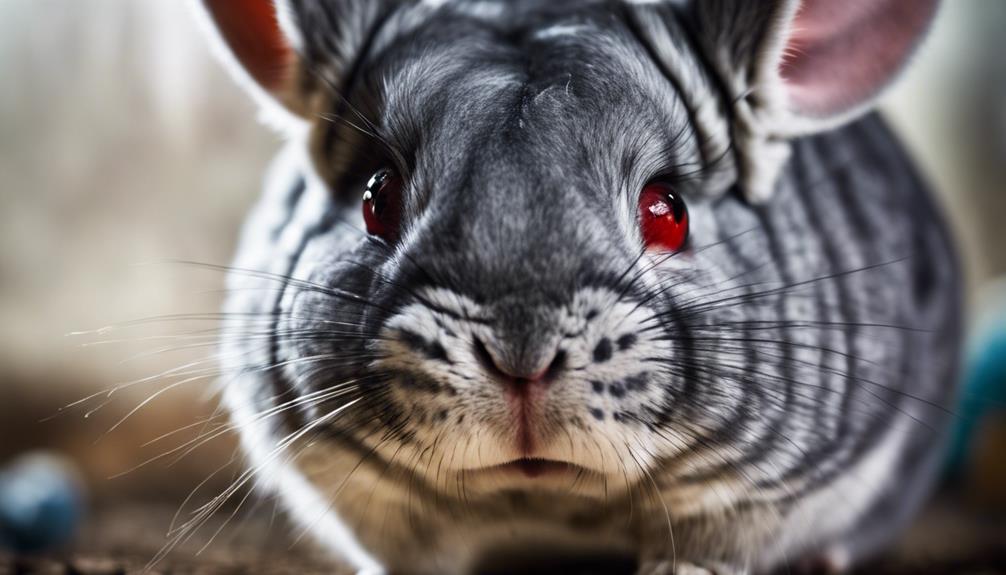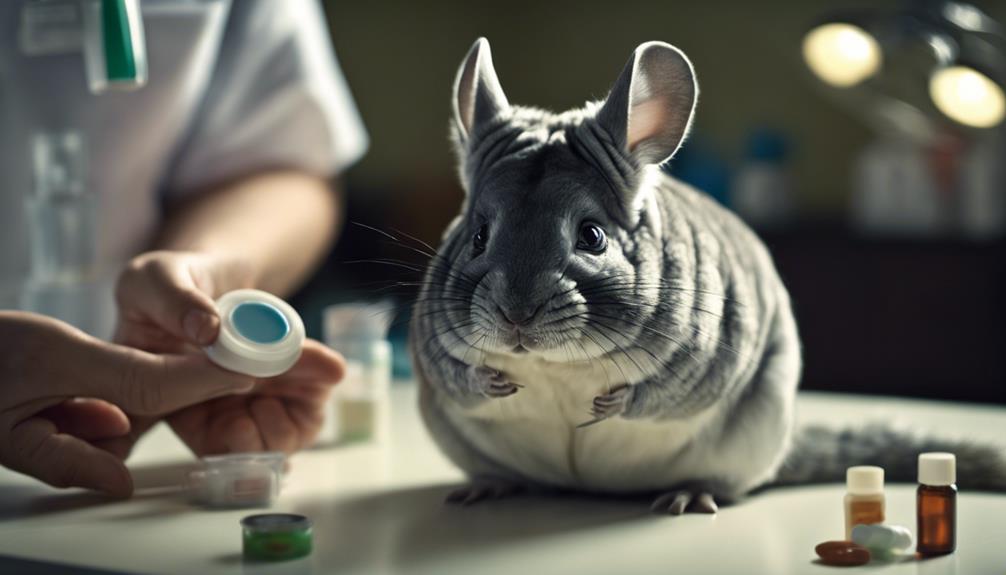How to Spot and Treat Fungal Infections in Chinchillas

Fungal infections in chinchillas can be a common health issue that requires prompt attention. These infections can affect various parts of the chinchilla’s body, such as the skin, ears, or respiratory system. Symptoms of fungal infections may include hair loss, scaly skin, redness, itching, or respiratory distress. If left untreated, fungal infections can lead to more severe health problems.
Treatment for fungal infections in chinchillas typically involves antifungal medications prescribed by a veterinarian. It is crucial to follow the vet’s instructions carefully and complete the full course of treatment to ensure the infection is fully eradicated.
Additionally, maintaining proper hygiene in the chinchilla’s environment, providing a balanced diet, and minimizing stress can help prevent fungal infections. Regular veterinary check-ups can also help catch any potential issues early on.
Symptoms of Fungal Infections in Chinchillas
Chinchillas with fungal infections typically exhibit symptoms such as scaly skin, hair loss, and excessive scratching. These signs may indicate a dermatophyte infection, commonly known as ringworm, which can affect chinchillas of all ages. Preventative measures play a crucial role in managing fungal infections in chinchillas. Ensuring a clean and dry environment for the chinchilla can help reduce the risk of fungal growth. Environmental factors, such as high humidity levels and poor ventilation, can create an ideal breeding ground for fungi. Regularly cleaning the chinchilla’s cage, providing proper ventilation, and avoiding overcrowding can help minimize the risk of fungal infections.
Observing these symptoms and understanding the environmental factors that can contribute to fungal infections is essential for chinchilla owners. By taking proactive measures to create a healthy living environment for their pets, owners can significantly reduce the chances of fungal infections and promote the overall well-being of their chinchillas.
Visual Signs to Look For

Chinchilla owners should be vigilant for visual signs that may indicate a fungal infection in their pets. These signs include:
- Skin redness and irritation
- Patchy fur loss
- The presence of white flaky areas on the skin
Recognizing these visual cues early on can prompt timely treatment and prevent the infection from worsening.
Skin Redness and Irritation
When observing a chinchilla for signs of fungal infections, one should pay close attention to any skin redness and irritation that may be present. Skin redness and irritation can be an indication of a fungal infection in chinchillas. Here are some visual signs to look for:
- Red patches on the skin
- Swelling or inflammation in affected areas
- Itchiness that leads to scratching or rubbing
- Dry, flaky skin
- Hair loss around the affected area
If you notice any of these signs, it’s crucial to address them promptly. Treatment options and home remedies, along with proper skin care and grooming techniques, can help alleviate skin redness and irritation in chinchillas.
Patchy Fur Loss
Patchy fur loss in chinchillas can be visually identified by uneven or bald spots on the coat. This can be a concerning sign of a fungal infection. When observing patchy fur loss, it is important to take action promptly. One approach to treating this condition is through antifungal medication prescribed by a veterinarian. Additionally, ensuring the chinchilla’s living environment is clean and dry can aid in the recovery process. Proper nutrition and supplements may also support the fur regrowth process. Chinchillas have a natural ability to regrow their fur, but this can be a slow process. Providing a stress-free environment and gentle handling can help facilitate the fur regrowth. Monitoring the chinchilla closely during this period is crucial for a successful recovery.
| Treatment Approach | Fur Regrowth Process |
|---|---|
| Antifungal medication | Proper nutrition |
| Clean living environment | Supplements |
White Flaky Areas
Upon closer inspection of your chinchilla’s coat, one should be vigilant for white flaky areas as potential indicators of fungal infection. These white flaky areas may appear on different parts of the chinchilla’s body and can signal an underlying issue that needs attention.
When dealing with such symptoms, it’s essential to consider treatment options and prevention methods to ensure the chinchilla’s health and well-being. Here are some key points to keep in mind:
- White flaky areas on the fur
- Increased scratching or itching by the chinchilla
- Redness or irritation around the affected areas
- Consultation with a veterinarian for proper diagnosis and treatment
- Regular cleaning of the chinchilla’s living environment to prevent fungal infections
Taking prompt action and implementing appropriate treatment options and prevention methods can aid in resolving fungal infections in chinchillas.
Behavioral Changes to Watch Out For

Look out for sudden changes in your chinchilla’s behavior as they could indicate the presence of a fungal infection. Behavioral changes such as increased aggression, lethargy, or unusual grooming habits could be stress indicators that something isn’t right with your pet.
If your chinchilla starts excessively scratching itself or showing signs of discomfort during social interactions, it might be trying to communicate that it’s experiencing some form of discomfort. Additionally, a chinchilla with a fungal infection may isolate itself from other chinchillas or show avoidance behaviors during playtime.
It’s essential to pay attention to any shifts in your chinchilla’s typical behavior and seek veterinary care if you notice these changes persisting. By being observant and responsive to your chinchilla’s behavioral cues, you can catch potential fungal infections early and ensure your pet receives the necessary treatment to recover swiftly and comfortably.
Diagnosing Fungal Infections in Chinchillas

When diagnosing fungal infections in chinchillas, it’s crucial to carefully observe for symptoms like skin irritation, hair loss, and unusual behavior.
Skin and fur inspection play a vital role in detecting potential fungal infections early on.
Seeking prompt veterinary consultation is essential to accurately diagnose and treat fungal infections in chinchillas.
Symptom Observation Methods
Effective diagnosis of fungal infections in chinchillas involves keen observation of specific symptoms that indicate the presence of such an infection. When observing a chinchilla for signs of a fungal infection, look out for:
- Patchy Hair Loss: Areas where fur is missing or thinning.
- Red, Inflamed Skin: Skin that appears irritated or reddened.
- Scaly Patches: Dry, flaky skin patches.
- Scratching or Rubbing: Excessive scratching or rubbing against surfaces.
- Unpleasant Odor: Foul smell emanating from the chinchilla’s fur.
Skin and Fur Inspection
Inspecting the skin and fur of a chinchilla is a crucial step in diagnosing fungal infections in these small rodents. To assess for potential issues, start by evaluating the fur texture for any abnormalities such as dryness or brittleness.
Next, carefully examine the skin for any signs of discoloration, which can indicate a fungal infection. Additionally, analyzing the overall condition of the coat is essential; a dull or unkempt appearance may suggest an underlying problem.
Keep an eye out for any areas of hair loss, as this can be a common symptom of a fungal infection in chinchillas. By conducting a thorough skin and fur inspection, you can promptly identify and address any fungal issues your chinchilla may be facing.
Veterinary Consultation Importance
A veterinary consultation is crucial for accurately diagnosing fungal infections in chinchillas. Seeking professional help ensures proper identification of the infection and appropriate treatment. Here are some key points to consider:
- Preventive Measures: A veterinarian can advise on how to prevent fungal infections through proper hygiene and habitat maintenance.
- Regular Check-ups: Scheduled visits to the vet can help catch any signs of infection early on.
- Proper Hygiene: Veterinarians can recommend the best practices for maintaining cleanliness in the chinchilla’s environment.
- Home Remedies: While some home remedies may be suggested, it’s essential to consult with a vet before trying any treatment.
- Professional Diagnosis: Only a veterinarian can provide a definitive diagnosis and recommend the most effective treatment plan.
Treatment Options Available

When considering treatment options for fungal infections in chinchillas, consulting a veterinarian experienced in exotic animal care is crucial. Veterinarians may recommend antifungal medications, such as oral medications or topical treatments like antifungal creams or shampoos, to combat the infection effectively. Additionally, natural remedies like diluted apple cider vinegar baths or tea tree oil solutions can help soothe the chinchilla’s skin and aid in the healing process.
Home care is also essential in treating fungal infections in chinchillas. It involves maintaining a clean environment for the chinchilla, washing bedding regularly, and disinfecting cages to prevent the spread of the infection. Regular grooming practices, like brushing the chinchilla’s fur and keeping it dry, can also aid in recovery. It’s crucial to follow the veterinarian’s instructions diligently, administer medications as prescribed, and monitor the chinchilla’s progress closely. With proper treatment and care, fungal infections in chinchillas can be effectively managed, leading to a healthy and happy pet.
Preventing Fungal Infections

To prevent fungal infections in chinchillas, maintaining proper hygiene practices is paramount for their well-being and health. Here are some essential tips to help prevent fungal infections in these adorable pets:
- Regular Bathing Techniques: Chinchillas shouldn’t be bathed in water due to their dense fur, which can retain moisture and lead to fungal growth. Instead, provide them with a dust bath 2-3 times a week to help keep their fur clean and dry.
- Cage Cleaning: Regularly clean and sanitize the chinchilla’s cage to prevent the buildup of bacteria and fungi. Remove any wet bedding promptly and ensure the cage is well-ventilated.
- Avoid Humid Environments: Chinchillas are sensitive to high humidity, which can promote fungal growth. Keep their living space dry and well-ventilated.
- Proper Diet and Nutrition: A healthy diet rich in fiber and essential nutrients will help boost your chinchilla’s immune system, making them less susceptible to infections.
- Regular Health Checks: Monitor your chinchilla for any signs of skin irritation, hair loss, or changes in behavior. Early detection can help prevent fungal infections from worsening.
When to Seek Veterinary Care

Seek veterinary care promptly if your chinchilla displays any concerning symptoms such as persistent skin lesions or unexplained changes in behavior. It’s crucial to recognize the signs that indicate a fungal infection may be present. While home remedies and online resources can offer some guidance, a professional veterinary evaluation is essential for an accurate diagnosis and appropriate treatment plan.
If you notice your chinchilla scratching excessively, experiencing hair loss, or developing scaly patches on its skin, it’s time to seek expert help. These symptoms could indicate a fungal infection that requires veterinary attention. Additionally, any behavioral changes like a decrease in appetite, lethargy, or unusual vocalizations shouldn’t be ignored.
Although it might be tempting to try home remedies or consult online resources first, delaying veterinary care can worsen your chinchilla’s condition. Veterinarians have the expertise to accurately diagnose fungal infections and provide effective treatment options tailored to your chinchilla’s specific needs. Remember, early intervention is key to ensuring your chinchilla’s health and well-being.
Frequently Asked Questions
Can Fungal Infections in Chinchillas Be Contagious to Other Pets or Humans?
Fungal infections in chinchillas can be contagious to other pets or humans. Prevent fungal transmission by isolating infected chinchillas, using proper hygiene practices, and seeking veterinary care promptly. Zoonotic risks exist, so take precautions when handling infected animals.
Are There Any Natural Remedies or Home Remedies That Can Help Treat Fungal Infections in Chinchillas?
When it comes to fungal infections in chinchillas, natural remedies like herbal treatments can be helpful. Implementing home care and preventative measures such as maintaining good hygiene and providing a clean environment can aid in treating and preventing these infections.
Can Chinchillas Develop Resistance to Antifungal Medications Over Time?
Ironically, chinchillas can surprise with their resilience to antifungal medications over time. It’s essential to explore diverse treatment options for chinchillas facing antifungal resistance, ensuring their well-being and recovery from fungal infections.
Are There Any Specific Dietary Changes or Supplements That Can Help Prevent Fungal Infections in Chinchillas?
Adding nutritional supplements rich in vitamins like Vitamin C and E can enhance chinchilla health and potentially prevent fungal infections. Dietary changes, such as offering high-quality hay and limiting sugary treats, also play a role in prevention.
How Long Does It Typically Take for a Chinchilla to Fully Recover From a Fungal Infection With Treatment?
Recovery timeline from a fungal infection in chinchillas varies, usually taking 2-4 weeks with proper treatment. Risks of relapse exist, requiring diligent monitoring. Treatment effectiveness can be gauged by observing symptom improvement over time.











